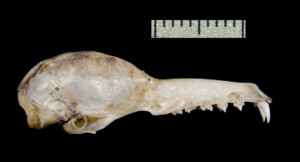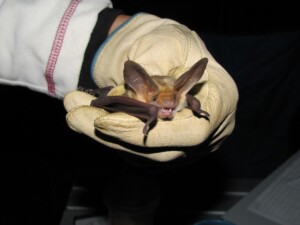Today is Bat Appreciation Day and these are my favorite Sky Island bat facts:
What Sky Island Bats Eat

Side view of a Mexican long-tongued bat showing its very small teeth that it doesn’t need! Photo by Phil Myers (photographer; copyright holder), Museum of Zoology, University of Michigan-Ann Arbor
Most bats are insectivorous, meaning they only eat insects like moths, flies, and mosquitos. However, there are some species of bats that only eat nectar from flowers. Those bats are called nectivores and their mouth and tongue are so adapted to eating only nectar that their teeth are tiny!
Bats Help Cactus and Agave
Both insectivorous and nectivorous bats play an important role in agriculture. Insectivorous bats act as a natural pest control, helping to regulate insect populations in crops and in the wild. Nectivorous bats help pollinate native plants and crops that rely on these flying mammals to reproduce. These include saguaro, Organ-pipe cactus, and agave that is the staple crop in tequila and mezcal production. The lesser long-nosed bat (Leptonycteris yerbabuenae) migrate every year
from Mexico to the United State, pollinating agave along the journey.
Bats Depend on Springs
Besides insects and nectar, bats rely on rare springs and streams across the desert for water. The water not only hydrates bats, but also creates habitat for the plants and insects these bats need to survive.
In 2014 Sky Island Alliance helped restore Ash Spring in the Chiricahua Mountains of Southern Arizona to provide a more accessible water source for bats. A bat survey was conducted after the restoration project and sixteen species of bats were detected!
How to Survey for Bats
We detect bats on our motion and heat-triggered wildlife cameras at night. Another way to survey for bats is to listen for them using sensitive microphones that can pick up the high-pitched calls bats make as they fly by and echolocate for food, each other, and features of the environment. The sound waves of each bat call appear as a unique sound pattern and frequency that is used by researchers to determine what species made the call.
See below for two different bat species with very different call patterns.
Some of the large species, like the greater mastiff bat (Eumops perotis), can be heard with just your ears alone. So next time you hear or see a bat, take time to appreciate these amazing creatures.




